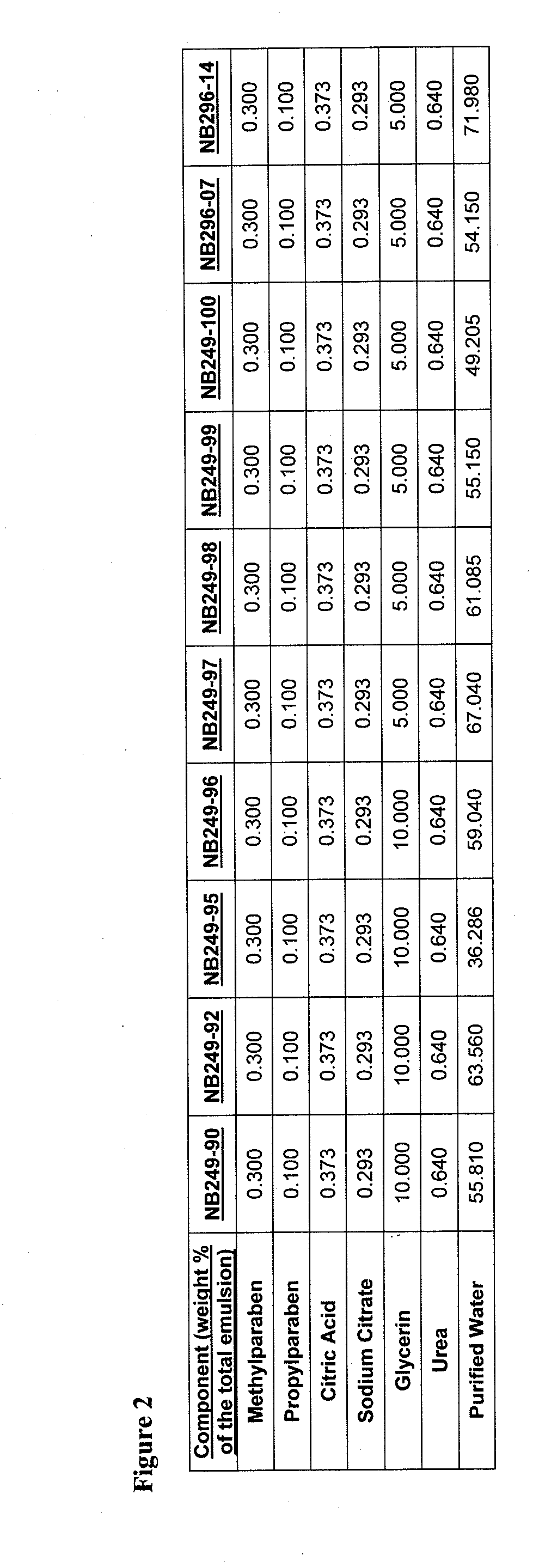High Oil-Content Emollient Aerosol Foam Compositions
- Summary
- Abstract
- Description
- Claims
- Application Information
AI Technical Summary
Benefits of technology
Problems solved by technology
Method used
Image
Examples
example 1
Compositions and Method of Manufacture
[0896]An example product concentrate (NB249-99) can be manufactured by the procedure outlined below:
[0897]Part A: Oil Phase Preparation[0898]1. Charge Ceteth-20 (I) light mineral oil, white petrolatum, dimethicone, safflower oil, butylated hydroxytoluene and cetostearyl alcohol into a stainless steel tank and heat until fully melted.
[0899]Part B: Aqueous Phase Preparation[0900]1. Charge Purified Water (I) and Glycerin into a stainless steel tank and heat to 75-80° C.[0901]2. Charge and dissolve citric acid (I) and sodium citrate (I) as well as urea, methyl paraben and propyl paraben while mixing.[0902]3. Continue mixing until a clear solution is obtained while maintaining a temperature of 65-95° C.
[0903]Part C: Drug Phase Preparation[0904]1. Charge a Stainless Steel tank with Purified Water (II), citric acid (II), sodium citrate (II) and Ceteth-20 (II).[0905]2. Mix slowly at room temperature to dissolve.[0906]3. Add hydrocortisone butyrate and m...
example 4
Product Densities
[0923]When dispensed from an aerosol can, the compositions of the invention form time- and temperature-stable low-density foams (FIG. 7). The densities of dispensed foam and non-foam compositions were measured as follows.
[0924]Product was dispensed into a conical receptacle of known weight and volume. The product was dispensed into the receptacle so that there are no voids. Excess material was removed from the top of the receptacle with a flat-bladed spatula. The mass of the test article and receptacle was determined with the test article density calculated using the formula:
Density=(MASST−MASSR) / VOLUMER
Where:
[0925]MASST=total mass of test article and receptacle[0926]MASSR=mass of receptacle[0927]VOLUMER=volume of receptacle
example 5
Formulation Stability in the Presence of Hydrofluorocarbon Propellants
[0928]The in-packaging physical stability of aerosol foam concentrates has a significant effect on their efficacy and consumer acceptability. Oil-in-water emulsion formulations such as the formulations of the invention are traditionally thermodynamically unstable and therefore will separate into two or more phases over time. The time required for this physical instability to manifest is dependent on temperature; higher temperatures tend to accelerate the separation of phases. While the oil and water phase compositions are well-known to affect formulation stability, variations in propellant composition within a propellant class are also considered to be a factor.
[0929]Fourteen different formulation variants were prepared and packaged in the presence of either HFA-134a or 50 / 50 blend of HFA-134a and HFA-227 and stored at 40° C. FIG. 8 summarizes the relative ratios of emollient oil, surfactant, and co-surfactant, th...
PUM
| Property | Measurement | Unit |
|---|---|---|
| Fraction | aaaaa | aaaaa |
| Fraction | aaaaa | aaaaa |
| Fraction | aaaaa | aaaaa |
Abstract
Description
Claims
Application Information
 Login to View More
Login to View More - R&D
- Intellectual Property
- Life Sciences
- Materials
- Tech Scout
- Unparalleled Data Quality
- Higher Quality Content
- 60% Fewer Hallucinations
Browse by: Latest US Patents, China's latest patents, Technical Efficacy Thesaurus, Application Domain, Technology Topic, Popular Technical Reports.
© 2025 PatSnap. All rights reserved.Legal|Privacy policy|Modern Slavery Act Transparency Statement|Sitemap|About US| Contact US: help@patsnap.com



